You’ll discover Tuktoyaktuk, one of Canada’s northernmost communities, during your Arctic cruise stop. The port sits at coordinates 69.445, -133.034, with the marine terminal open 8 AM to 5 PM on weekdays.
For other Canada Cruise destinations check out our Canada Cruise Ship Ports Guide page.
The summer months offer you three key attractions:
- Over 1,350 pingos (ice-cored hills)
- Beluga whale watching spots
- 24-hour daylight views
You can experience local Inuvialuit culture through:
- Guided community walks
- Hands-on craft workshops
- Traditional food tastings
Two main shopping locations await you:
- Pingo Market
- Nautchiaq Fur Shop
Your visit can include:
- Northern Lights viewing
- Learning about hunting traditions
- Cultural demonstrations
The port provides direct access to both natural landmarks and cultural sites, making it easy to explore this unique Arctic community.
🐧 Polar Cruise Enquiry 🐻❄️
Our team of polar travel specialists have personally explored both the Arctic and Antarctic regions – from tracking polar bears in Svalbard to kayaking with penguins off the Antarctic Peninsula. Let us find the right polar expedition cruise for you.
Arriving at Tuktoyaktuk Harbor

You’ll enter Tuktoyaktuk Harbour through the Beaufort Sea, passing through Kugmallit Bay near the Mackenzie River Delta. The harbour sits at coordinates 69.445, -133.034. The air temperature drops to -27°C with a light breeze, so you’ll need warm clothing when you head to your assembly point for docking.
Tugboats guide your ship safely into position at the pier. The harbour can handle several ships at once, with strong mooring lines keeping each vessel secure.
Your ship’s team works with local pilots and port officials throughout your arrival, following strict Arctic safety rules.
Port Details and Services
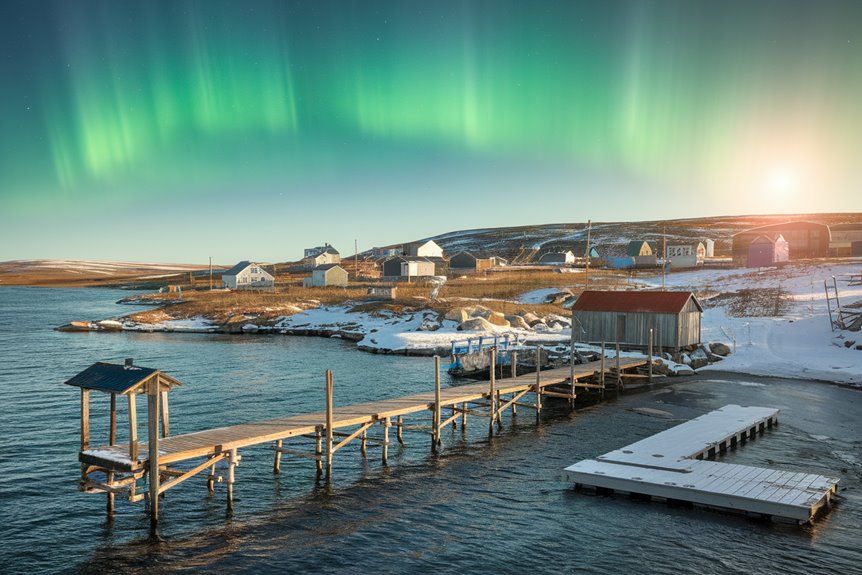
You can access the Tuktoyaktuk port’s marine terminal facilities with your cruise ships and cargo vessels between 8 AM and 5 PM, Monday to Friday.
The terminal meets ISPS Code security standards to protect your vessel whilst docked. You need to contact the MTS Customer Service Desk before arrival to arrange any port services.
Two key providers support your vessel needs: CBSA and E. Gruben’s Transport Ltd.
Harbor Depth and Access
Tuktoyaktuk Harbour sits at 69°27′0.00″N 133°0′0.00″W on the Beaufort Sea.
You can find two main docking areas: the cargo pier (3.4m to 4.6m deep) and the oil terminal (4.9m to 6.1m deep).
The harbour lies next to Kugmallit Bay, with Tuktoyaktuk Island offering protection from rough weather.
You need icebreaker support during ice season, and your vessel must be ice-strengthened or travel with a Canadian icebreaker.
The harbour’s compact size requires careful navigation.
The seabed contains permafrost reaching 5m to 20m below sea level north of Tuktoyaktuk Island.
You can reach the port by road using the Inuvik Tuktoyaktuk Highway.
Available Port Facilities
You’ll find Tuktoyaktuk port open from early July to late September for cruise ships and cargo vessels.
The port limits vessels to 4.27 metres draft and offers break bulk, liquid, and dry dock services. Basic repair and towing support are available.
The port maintains two crane categories:
- Small cranes: 0-24 metric tonnes
- Medium cranes: 25-49 metric tonnes
You can access standard port services including:
- Provisions supply
- Bunkering facilities
- Basic vessel support
The port serves as a vital supply centre for northern communities.
You should note that Tuktoyaktuk lacks emergency response facilities.
Key limitations:
- No heavy-lift cranes
- Limited navigation season
- Basic berthing facilities
- Restricted draft depth
Weather and Best Times
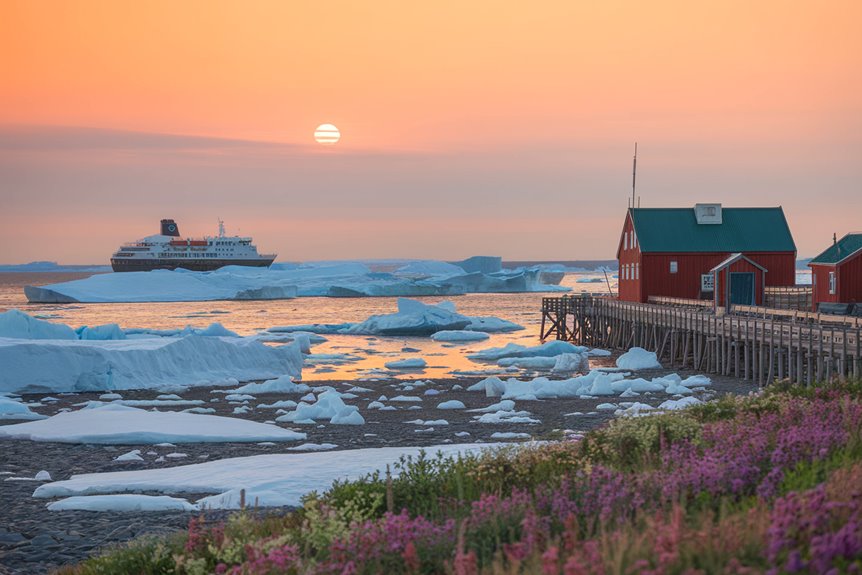
Tuktoyaktuk’s weather follows the Arctic Ocean’s patterns, which affects your travel options throughout the year.
You’ll experience extreme temperatures, from winter lows of -25.8°C to summer highs of 15.5°C in July.
You can only take cruises during the summer months, as the ocean stays frozen in winter. Even in summer, you should pack for sudden temperature drops and freezing conditions.
The maritime climate means:
- Winters are harsh and make sea travel impossible
- Summers are cool but manageable for cruising
- Weather can change quickly at any time
- Sea spray can freeze even during warmer months
Seasonal Temperature Patterns
Tuktoyaktuk’s temperatures change dramatically throughout the year, and you’ll need to plan your visit carefully.
July gives you the warmest weather at 17°C, whilst March plunges to -28°C. You can enjoy outdoor activities most comfortably from June to August, when temperatures stay above 0°C.
Summer months offer you:
- Temperatures between 12-17°C
- Perfect conditions for exploring the shore
- Plenty of daylight for sightseeing
Spring brings:
- A sharp rise from -19°C in March
- Warming to 2°C by May
- Highly variable daily temperatures
Autumn shows:
- A steady cooling pattern
- 7°C in September
- -12°C by November
You’ll need to pack different clothing layers for spring and autumn visits, as temperatures can change quickly during these seasons.
Arctic Winter Conditions
Winter cruising near Tuktoyaktuk brings extreme Arctic conditions you need to prepare for.
You’ll face temperatures between -22°C and -26°C in January and February, with humidity reaching 75%. Snow is the main form of precipitation at 4-6mm monthly, and you can expect visibility of around 18-19km.
Your vessel must be ice-strengthened for Arctic navigation.
You should know that communication systems can fail due to weather and terrain. You won’t find repair facilities in the Canadian Arctic, so your ship needs thorough preparation before departure.
The wind blows at an average of 22 km/h, making conditions more challenging.
You must submit your vessel’s travel plans to local authorities well before your journey.
These harsh Arctic conditions require careful planning and specialised equipment for safe navigation.
Summer Navigation Window
Summer Navigation in Tuktoyaktuk’s Waters
You can navigate Tuktoyaktuk’s waters best from 20 May to 25 July during polar days. Daylight stays constant during this period, making your journey smoother.
Peak sailing months are June and July:
- July temperatures: 17°C (highs), 8°C (lows)
- June temperatures: 12°C (highs), 3°C (lows)
July conditions give you:
- 22 hours of daylight for exploring
- 25 km/h winds with 23 km visibility
- 70% humidity and 37.2 mm rainfall
- Perfect weather for pingo visits
Your cruise ship will travel with:
- Canadian icebreaker support
- Ice-strengthened vessel assistance
You’ll find June offers similar daylight advantages with cooler temperatures, making it another excellent choice for your journey.
Cultural Heritage Experience
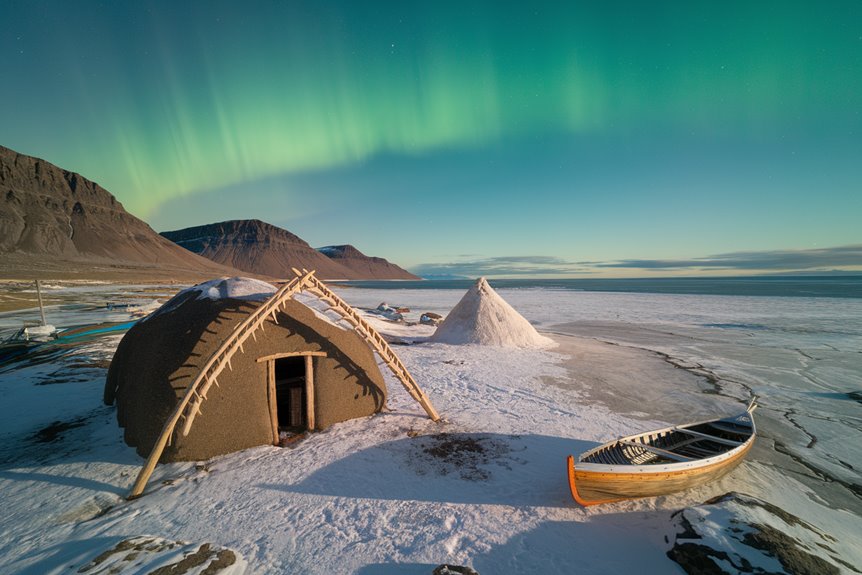
Experience ancient Inuvialuit culture in Tuktoyaktuk, where the Kittegaryumiut Inuit people lived as skilled whale hunters for centuries.
You can explore this heritage despite the community’s tragic losses to early 1900s epidemics.
The Saliqmiut Project connects you directly with local traditions. You can join workshops, explore museum displays, and watch artisans at work in the arts centre.
You’ll discover detailed bone carvings, intricate antler art, and get to taste authentic dishes like muktuk and smoked beluga.
You can take guided walks to the Pingo National Landmark to understand these ice-cored hills that define the Arctic landscape.
Local elders share their stories with you, while contemporary artists show you how they keep traditional skills alive through modern artwork.
Local Community Encounters

Visiting Tuktoyaktuk lets you experience genuine Inuvialuit culture firsthand.
You’ll learn from local Indigenous guides who share their knowledge through cultural activities and food tastings. Try traditional Arctic foods like muktuk whilst learning about daily life in this remote community.
What you can do:
- Learn traditional crafts in hands-on workshops
- See local hunting and fishing methods
- Take photos at the community Welcome Sign
- Join seasonal community celebrations
Your local guide will share personal stories and show you how the community combines traditional practices with modern living.
You’ll discover how the Inuvialuit people maintain their cultural heritage whilst adapting to contemporary Arctic life.
Each visit supports the local community directly and helps preserve Indigenous traditions. Your guide will help you understand both historical customs and present-day challenges of Arctic living.
The Inuvialuit community welcomes visitors warmly, making it easy for you to learn about their unique way of life.
You’ll gain practical insights into how people thrive in this remote Arctic setting.
See what’s on offer from the Herschel Island, Yukon, Canada for a different Canada Cruise destination.
Traditional Hunting and Fishing

Traditional hunting and fishing shape Tuktoyaktuk’s daily life and cultural heritage. You can observe local hunters tracking different animals throughout the seasons – mountain goats emerge in spring, whilst caribou roam during winter months.
Community members craft their hunting tools with care, fashioning bows from cedar and yew wood, and creating specific arrows for each target animal.
The sea provides vital resources through beluga whale and seal hunting traditions. These hunts strengthen community bonds, as hunters share their catch with all neighbours.
You can witness how the community adapts to changing conditions, as climate shifts affect animal patterns and available catches. Traditional methods persist, including deer hunting with trained dogs and fishing from handmade canoes.
The community preserves these practices whilst evolving with modern challenges. You’ll find hunters combining age-old knowledge with current conservation awareness, ensuring sustainable harvests for future generations.
These activities remain central to local food security and cultural education, passing vital skills from experienced hunters to younger community members.
Natural Arctic Attractions
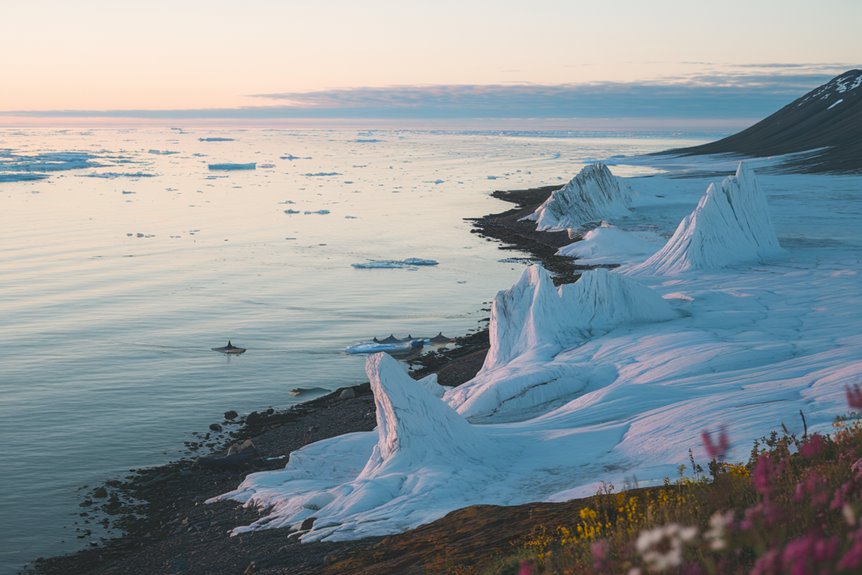
The Natural Wonders of Tuktoyaktuk
You’ll discover over 1,350 pingos in Tuktoyaktuk – unique ice-hills that rise from the frozen ground. The Ibyuk Pingo stands as Canada’s highest and the world’s second-tallest pingo. You can explore these Arctic formations via a 400-metre boardwalk, choosing between:
- Summer: boat or kayak tours
- Winter: snowmobile trips across the tundra
The area offers you year-round natural attractions:
- Beluga whales swimming near the shoreline (summer)
- Midnight sun (summer) and Northern Lights (winter)
- Migrating caribou herds
- Arctic plants and berries (summer)
You can rent equipment or join guided tours to get close to these natural landmarks.
The Pingo Canadian Landmark area provides the best viewing spots for these ice-cored hills.
Shopping and Local Crafts

You can discover local Inuvialuit crafts at two main locations in Tuktoyaktuk.
The Pingo Market in Kitti Hall specialises in traditional artwork, while the Nautchiaq Fur Shop offers handmade seal skin items and beaded decorations.
Both shops stock carvings and cultural pieces from local artists.
You’ll find work by Maureen Gruben, who combines natural materials with modern elements in her distinctive installations.
Visit the Pingo Market on Tuesday, Thursday and Saturday afternoons.
The Nautchiaq Fur Shop opens daily with longer hours on weekdays.
Note: the text has been simplified while maintaining essential information about locations, items, and opening times. The language is more direct and accessible, following clear subject-verb-object patterns.
Local Art Galleries
You’ll discover authentic Inuvialuit art and culture at several galleries in Tuktoyaktuk. The Saliqmiut: Tuktuuyaqtuuq Centre stands at the heart of the local art community.
The Centre offers you:
- Direct access to traditional artworks
- Live demonstrations by local artists
- Historical documents and photographs
- Cultural workshops with Inuvialuit Elders
- Modern exhibition spaces
- Archive collections of northern art
You can watch artists work in shared studio spaces, join hands-on workshops, and learn about Inuvialuit heritage directly from community members.
The Centre connects you with both traditional and contemporary northern art forms.
The space welcomes cruise ship visitors and provides a genuine glimpse into Arctic artistic expression.
You’ll find the exhibits well-organised and easy to navigate, with clear descriptions in both English and Inuvialuktun.
Traditional Inuvialuit Handicrafts
Traditional Inuvialuit artisans craft authentic pieces in Tuktoyaktuk using seal skin, fur and beadwork. You can find these handmade items at several locations across town.
The Pingo Market at Kitti Hall stocks locally made traditional clothing and kamiks (Inuvialuit footwear).
The Nautchiaq Fur Shop offers decorative pieces made from caribou hide and fur.
Local craftspeople like Debbie Raddi and Kayla Nuyaviak create traditional clothing and accessories using seal skin and natural materials.
You can buy these handicrafts at Steen Enterprises Ltd or directly from artists through the Tuktoyaktuk Community Corporation.
Your purchase supports local artisans and helps preserve Inuvialuit traditions.
Safety and Environmental Guidelines
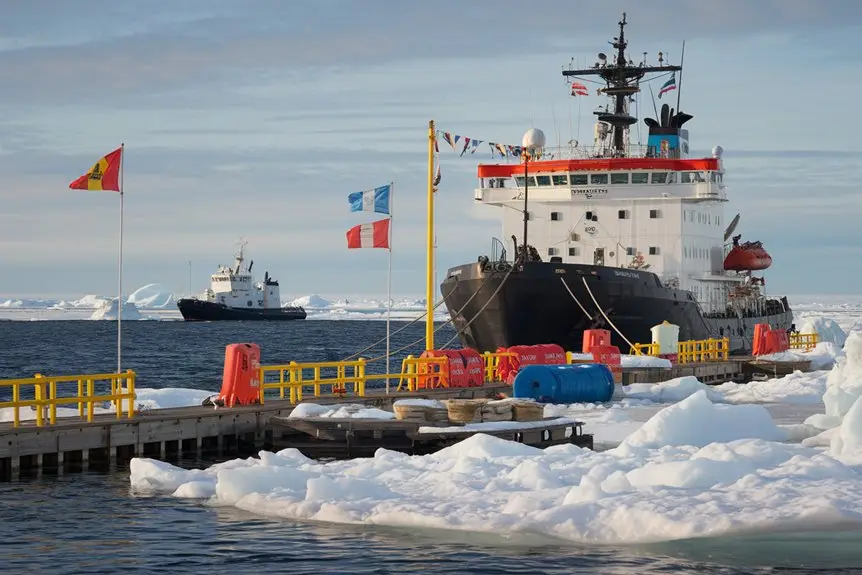
Visit Guidelines for Tuktoyaktuk Cruise Ships
You must follow three key rules when visiting Tuktoyaktuk:
- Safety measures
- Environmental protection
- Cultural respect
Before Your Arrival:
- Contact Canadian Marine Communications
- Complete all security checks
Environmental Rules:
- Keep your distance from marine mammals
- Store all waste onboard – no dumping in the harbour
- Reduce engine noise to protect sea life
- Stay in small groups of 15 or fewer with your guide
These guidelines help you protect Tuktoyaktuk’s natural environment and ensure your safe visit to this Arctic community.
You can enjoy your experience while respecting local regulations and wildlife. Your compliance with these rules supports the community’s efforts to maintain its pristine Arctic environment.
You’ll find the local authorities are strict about these measures to preserve their unique ecosystem.
Shore Excursion Highlights
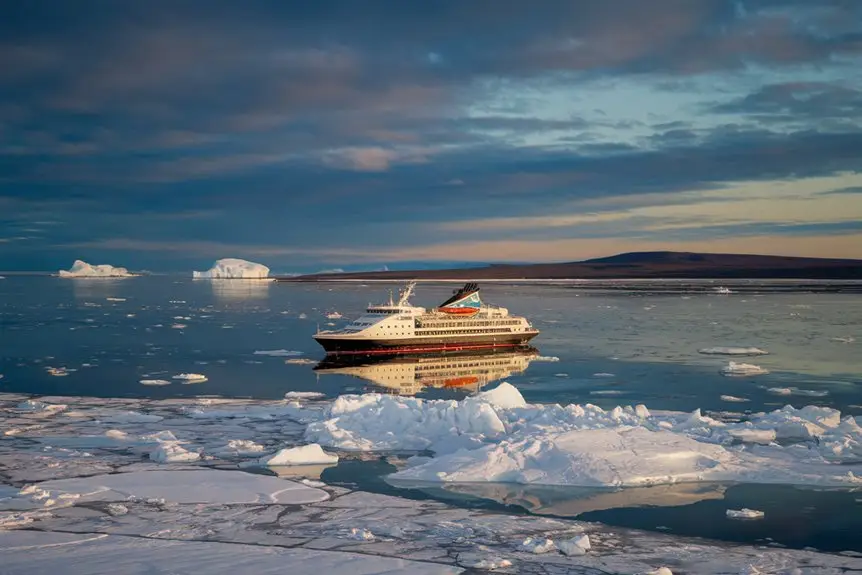
Your Arctic adventure in Tuktoyaktuk includes unique cultural and natural experiences.
You’ll visit the historic Lady of Lourdes Schooner, explore traditional Inuvialuit sod houses, and discover a former DEW Line site from the Cold War era.
The Canadian Pingo National Landmark offers you views of the Ibyuk Pingo, a massive ice-cored hill rising 15 storeys high.
You can access North America’s only Arctic Ocean point that connects to a public highway, making it perfect for a memorable toe-dip in the icy waters.
Your local guide will teach you about Inuvialuit traditions and offer you authentic Arctic foods to taste.
You’ll spot diverse wildlife in the Mackenzie Delta and learn about life in the Far North.
You can choose additional activities like:
- Northern lights photography tours
- Boat trips through the delta’s waterways
- Scenic flights to Herschel Island for wildlife watching
Frequently Asked Questions
Where Can Passengers Find Public Restrooms in Tuktoyaktuk?
Public toilets in Tuktoyaktuk are available at these locations:
- Visitor Information Centre (cleanest and most reliable)
- Trans-Canada Monument
- Sod Houses near Northmart
- End of the Road Restaurant
You can always count on the Visitor Centre for well-maintained facilities during operating hours.
Are There ATMS or Banking Services Available in Town?
You can access two ATMs in town:
- One at the Northern Store
- One at Stanton’s grocery store
Both ATMs charge above-average withdrawal fees, so you’ll save money by planning your cash withdrawals in advance.
What Cellular Network Providers Offer Coverage in Tuktoyaktuk?
You can access mobile coverage in Tuktoyaktuk through Bell and Telus networks, which offer basic 3G and 4G LTE services. You’ll connect successfully with any mobile provider that uses these networks, including:
- Koodo
- Public Mobile
- Lucky Mobile
Signal strength varies throughout the area, and you should expect basic rather than premium coverage levels.
Can Visitors Send Postcards From Tuktoyaktuk?
You can send postcards from Tuktoyaktuk through Canada Post’s most northerly post office. The office has limited opening hours, so you’ll need to check current times before visiting. The local shops stock unique Arctic-themed postcards that showcase the region.
Remember to:
- Visit during confirmed opening hours
- Buy local postcards from nearby shops
- Bring correct postage for international mail
- Allow extra time for postal delivery from this remote location
Are There Medical Facilities Available for Minor Emergencies?
The Rosie Ovayuak Health Centre provides basic medical care for your minor emergencies. You can access a nurse on call when needed. The centre operates Monday to Friday. You can reach the medical team at (867) 977-2321.
Thinking about something different? Check out the cruises leaving from Cambridge Bay, Victoria Island, Canada.
🐧 Polar Cruise Enquiry 🐻❄️
Our team of polar travel specialists have personally explored both the Arctic and Antarctic regions – from tracking polar bears in Svalbard to kayaking with penguins off the Antarctic Peninsula. Let us find the right polar expedition cruise for you.
